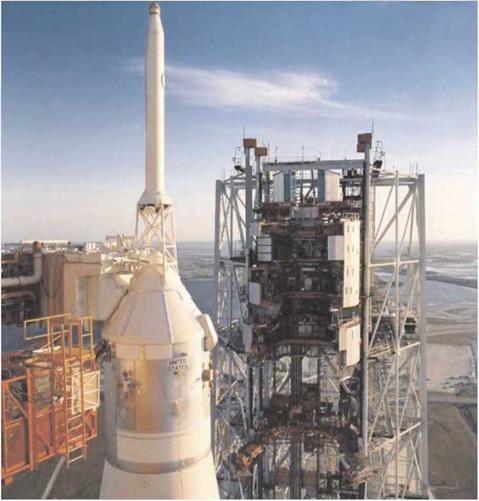Preparing the spacecraft
Most of the preparation of the CSM and LM was completed while the mobile service structure was still around the space vehicle. All the food and equipment in the two craft had been packed into their designated storage spaces, and their propulsion tanks filled with storable propellant long before loading of the Saturn V began, ensuring that, on the day of launch, only a few final tasks remained to be completed by hand. Throughout the countdown, and for much of the journey to the Moon, the LM was without power and inert, saving its precious batteries for its foray to the lunar surface. The CSM, on the other hand, was a buzzing, vibrant machine wrhose health was monitored closely by flight controllers and contractors throughout the countdown in case a problem occurred.
While on the pad. the CSM was pow’ered by electricity supplied from the ground. For flight, power came from fuel cells that made eleeiricity by reacting cryogenic
|
The Apollo 8 CSM as the mobile service structure was withdrawn. (NASA) |
hydrogen and oxygen from tanks in the service module. Two days prior to launch, these tanks were filled with reactants and their contents checked for contamination before they were permitted to enter the fuel cells. Rechargeable chemical batteries augmented the spacecraft’s power requirements in space, and these were fully charged as part of the launch preparations.
One member of the backup crew, usually the backup command module pilot, entered the command module prior to the crew’s arrival and ran through an extensive checklist to ensure that every switch, knob and indicator was correctly set for launch. There were hundreds of these, each taking a line of the checklist. In the later Apollo flights, there were over 450 lines to be checked before the prime crew arrived. With that done, the backup crewman usually waited for the crew to arrive
before he retired to the launch control centre to continue working with them by voice up to the point of launch.











